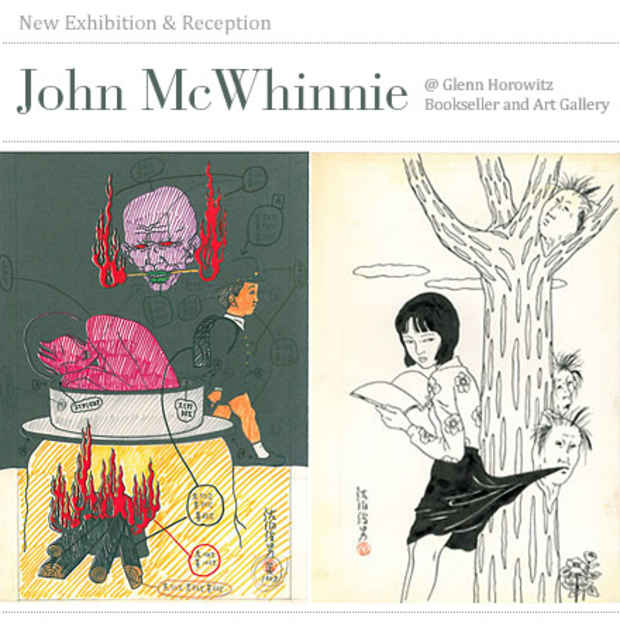Toshio Saeki "Oedipal Indescretions, Edible Obsessions: Early Work of Toshio Saeki"
John McWhinnie @ Glenn Horowitz Bookseller

This event has ended.
Cannibalism, rape, and torture; perverse is merely a starting point for these vivid, fantastical tableaux of deviant sexual theater, laced with mutilation, horror, and dread. A singular artist in many senses, Saeki did not ever color his own works, but saw himself as part of the traditional partnership deployed by the Ukioy-e woodcut masters, which reserved separate roles for the artist (Eshi) and the printer (Surishi). The works on display are presented in the original working form, as black and white line drawings overlaid with vellum sheets marked with Saeki’s color plans for the visualized finished printed image. Saeki refers to his method of practice as Chinto printing.
Born in 1945 Toshio Saeki grew up in the radically transforming culture of post-war Japan. Japanese social mores shifted dramatically in the immediate aftermath of WWII and there was a great liberalization in attitudes relating to sexual behavior. Publishers began freely printing material with sexual content and previously suppressed literature and graphics devoted to themes of deviant sexuality which had flourished for a short while in the 20s and 30s – Ero Guro Nansensu (roughly “erotic, grotesque, nonsense”) – re-emerged and found a willing audience. This popular “pulp” explosion echoed that experienced in the post war United States, but license was broader in Japan and, harkening back to the earlier Ero Guro era, and indeed the earlier tradition of Shunga (popular printed erotic imagery), a sub genre, hentai seiyoku, emerged with a particular focus on fetishistic and extreme scenarios. Bondage, sado-masochism, love suicides, and ritual disembowelment (seppuku) were themes of great interest in these publications. In 1970 the topic of seppuku projected hugely onto the nation’s consciousness with the ritual self disembowelment of the internationally celebrated author Yukio Mishima following a failed royalist coup. It was against this background that Saeki evolved his graphic erotic universe.
The work is strongly characterized as Japanese in its depiction of typical interiors, clothing, and types. Saeki rarely tries to suggest a trans-national scenario or environment. He hones close to the physical world he knows and this lends the images – so surreally shocking in other ways – an added strength of impact. But the real language of these scenes derives from the unconscious and the world of dreams. The artist recalls his wish to illustrate his own scary dreams as a young man as part of the evolution of his work. As essentially Japanese as the scenes and characters may be, the graphic potency of what is shown and the themes addressed speaks directly to the viewer’s unconscious, those awarenesses typically kept out of sight from the censorious ego. The body as a site of pain, mortification, shame and betrayal, and as the victim and source of an uncontrollable sexual desire, is primary. The body dissolves or is split open to admit or release irresistible urges. Demons and bogies approach or assault from all sides and vulnerability and purity only prompt us to pity in the face of a predatory, perverse and pitiless fantasy world.
It is due in no small part to the artist’s ability to push further into the realms of the taboo, to transgress further than fellow practitioners of the illustrative extremism so characteristic of contemporary comics and manga, that this work stands in a class of its own. “I’m just mischievous and like to surprise people… The more I produce the work, the more I want to top myself each time, to shock people even more.” In the past, in Japan, his books have received local government cautions from decency monitors. It would be difficult to conceive of U.S. censors taking such a lenient attitude, even by today’s standards. An explicit connection between horror and sexuality has become more mainstream in the last few decades, particularly with relation to popular cinema. The Japanese series of Ju-on horror films that began in the 90s pay indirect homage to the artist, featuring the somewhat malign child spirit Toshio Saeki, a witness of his mother’s murder at the hands of his father over sexual jealousy. Children and adolescents are a frequent presence in the artist’s work. The, to date, cultish following of Saeki’s oeuvre is about to readily expand significantly as public tastes catch up with his aesthetic. Apart from several shows of works in France (at the very first of which in 1970 all the pieces were stolen), the work has not been widely exhibited on an international platform. This exhibition offers a rare opportunity to view primary materials by the artist, with his printing notations and formulae, that are part of the process involved in creating a Toshio Saeki finished piece.
Since their first publication in 1970, Toshio Saeki’s erotic drawings have found a small but devoted audience in his native Japan. He has worked since then on commission and privately, delving deeper into a personal world of obsessive erotic illustration. Several publications of collected works emerged in the 70s in Japan, and then again later in the 90s including Saeki Toshio Gashu, Akai-Hako (Red Box), Chimushi I, and Chimushi II, and Yume Manji (Dream Swastika). His first U.S. publication, Onikage, is planned for release later this year by Last Gasp in San Francisco. His work has been shown frequently in solo shows in Japan and in France, and has been featured in shows at the Gray Box Gallery in San Jose, “Contemporary Japanese Erotica” in Los Angeles, and at “Art & Lust” in Miami. He presently lives and works in the small town of Ichihara, Chiba, Japan.
Media
Schedule
from May 12, 2010 to June 12, 2010
Opening Reception on 2010-05-12 from 18:00 to 20:00